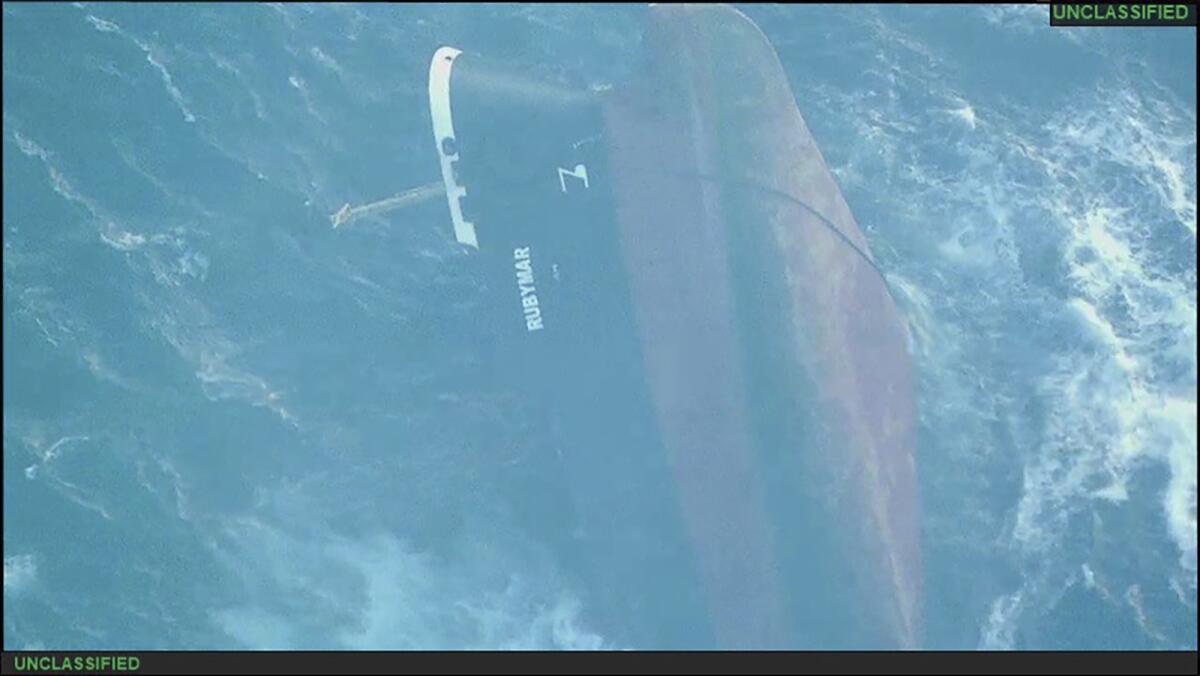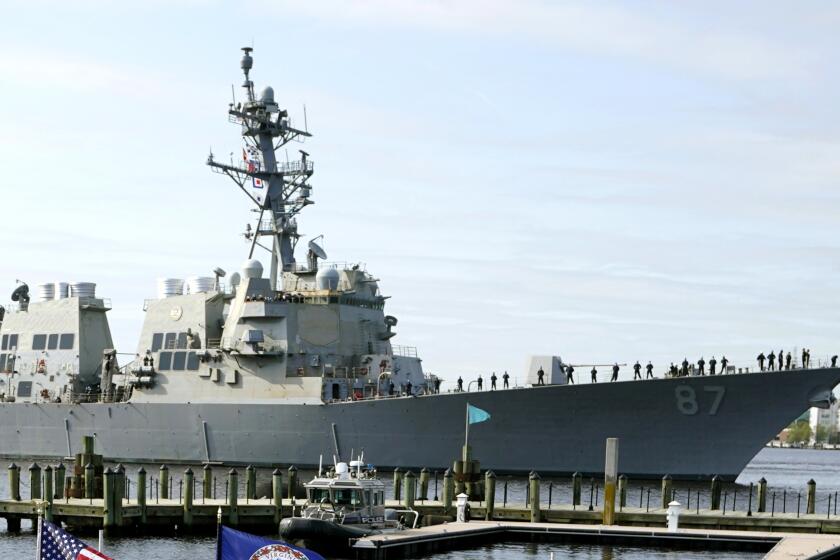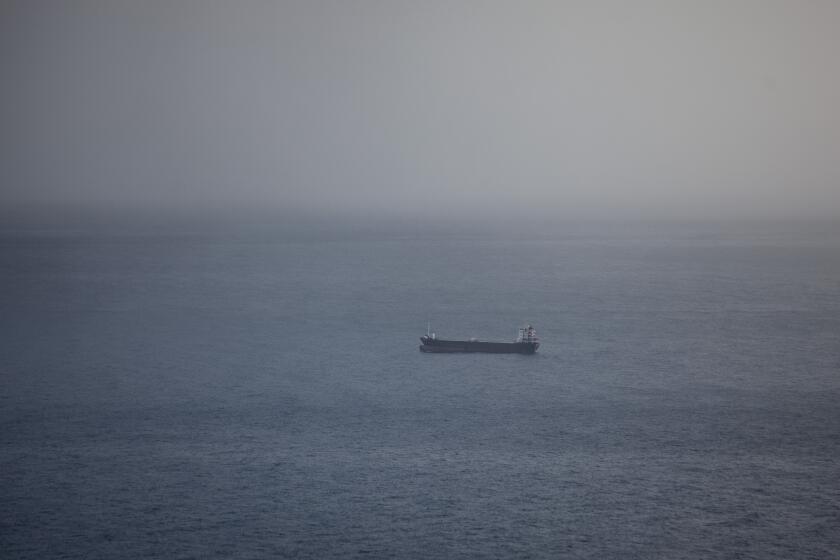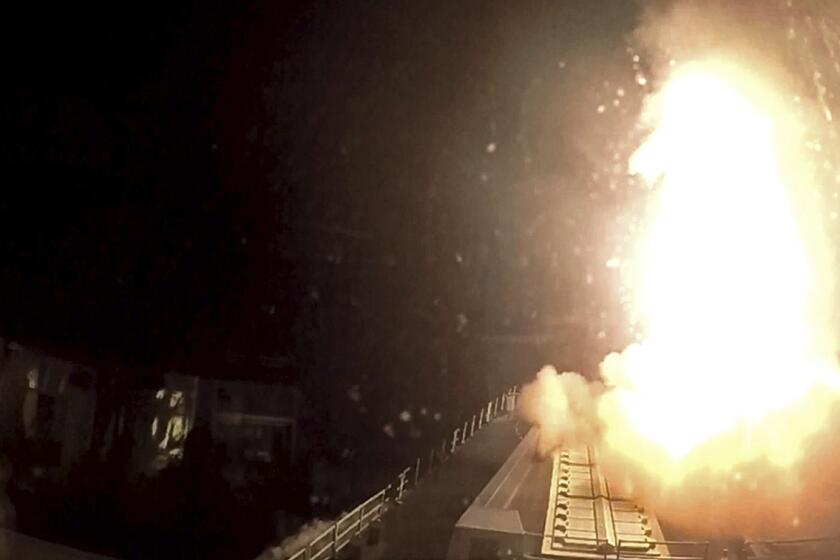Red Sea underwater data cables cut as Houthi attacks continue in the vital waterway

- Share via
DUBAI, United Arab Emirates — Three Red Sea underwater cables providing internet and telecommunications around the world have been cut as the waterway remains a target of Yemen’s Houthi rebels, officials said Monday. Meanwhile, a suspected Houthi attack set a ship ablaze in the Gulf of Aden.
What cut the lines remains unclear. There has been concern about the cables being targeted in the Houthi campaign, which the rebels describe as an effort to pressure Israel to end its war on Hamas in the Gaza Strip. The Houthis have denied attacking the lines.
While global shipping has already been disrupted through the Red Sea, a crucial route for cargo and energy shipments from Asia and the Middle East to Europe, the sabotage of telecommunication lines could further escalate the months-long crisis.
The attacks on commercial ships in the Red Sea by Yemen’s Houthi rebels have rerouted most global trade away from the artery for consumer goods, energy supplies.
The cut lines include Asia-Africa-Europe 1, the Europe India Gateway, Seacom and TGN-Gulf, Hong Kong-based HGC Global Communications said. It described the cuts as affecting 25% of the traffic flowing through the Red Sea. It described the Red Sea route as crucial for data moving from Asia to Europe and said it had begun rerouting traffic.
HGC Global Communications described the Seacom-TGN-Gulf line as being two separate cables when it is actually one at the area of the cut, according to Tim Stronge, a subsea cable expert with TeleGeography, a Washington-based telecommunications market research company.
Responding to questions from the Associated Press, Seacom said that “initial testing indicates the affected segment lies within Yemeni maritime jurisdictions in the Southern Red Sea.” It said it was rerouting what traffic it could, though some services were down.
Tata Communications, part of the Indian conglomerate and behind the Seacom-TGN-Gulf line, told the AP it “initiated immediate and appropriate remedial actions” after the line was cut.
The targeted money exchange services from Yemen and Turkey are believed to have funded Iranian-backed Houthi rebels who have attacked commercial vessels.
“We invest in various cable consortiums to increase our diversity and hence in such situations of a cable cut or snag, we are able to automatically reroute our services,” Tata said.
Other firms behind those lines, which provide data to Africa, Asia and the Middle East, did not immediately respond to queries Monday from the AP.
In early February, Yemen’s internationally recognized government in exile alleged that the Houthis planned to attack the cables. The lines appeared to have been cut on Feb. 24, with the organization NetBlocks noticing internet access in the East African nation of Djibouti suffering from interruptions two days later. Seacom serves Djibouti. There have been disruptions in Bahrain as well, a Persian Gulf island kingdom also served by the lines.
But for their part, the Houthis have denied targeting the cables. The rebels blamed the disruptions on British and U.S. military operations but did not offer evidence to support the allegation and have made false claims in the past.
More nations have joined the international maritime mission to protect vessels in the vital waterway, and trade traffic has begun to pick up.
“The hostilities on Yemen by the British and U.S. naval military units caused a disruption in the submarine cables in the Red Sea, which jeopardized the security and safety of international communications and the normal flow of information,” the Houthi-controlled Transportation Ministry in Yemen’s rebel-held capital, Sana, alleged.
Since November, the rebels have repeatedly targeted ships in the Red Sea and surrounding waters over the Israel-Hamas war. Those vessels have included at least one with cargo bound for Iran, the Houthis’ main benefactor, and an aid ship later bound for Houthi-controlled territory.
Despite more than a month and a half of U.S.-led airstrikes, Houthi rebels have remained capable of launching significant attacks. They include the attack last month on a cargo ship carrying fertilizer, the Rubymar, which sank on Saturday after drifting for several days, and the downing of an American drone worth tens of millions of dollars.
The Houthis insist their attacks will continue until Israel stops its combat operations in the Gaza Strip, which have enraged the wider Arab world and seen the Houthis gain international recognition.
A ballistic missile fired by Yemen’s Houthi rebels has slammed into a cargo ship in the Red Sea near the strategic Bab el-Mandeb Strait.
Meanwhile, the British military’s United Kingdom Maritime Trade Operations center on Monday separately warned of a new attack in the Gulf of Aden. The private security firm Ambrey described the vessel targeted as a Liberia-flagged, Israel-affiliated container ship that sustained damage and issued a distress call.
“The container ship reportedly encountered two explosions of which the first occurred at a ‘distance’ off its port quarter, while the second damaged the vessel’s accommodation block and a container leading,” Ambrey said. “The explosion further led to a fire onboard and the crew’s firefighting efforts were underway.”
Ambrey said no crew member on the ship had been injured. The U.S. Navy’s 5th Fleet, which patrols the Mideast, did not immediately respond to questions about the attack.
The Houthis did not immediately claim the attack, but it typically takes them several hours before they acknowledge an assault.
It remains unclear how the Houthis could attack subsea cables themselves. The rebels are not known to have the diving or salvage capability to target the lines, which sit hundreds of yards below the surface of the waterway.
Yemen’s Houthi rebels have fired their largest barrage of drones and missiles on shipping in the Red Sea, prompting the U.S. and British navies to respond.
However, subsea cables can be cut by anchors, including those dropped from some of the ships that have been disabled in attacks. A drifting ship with its anchor scraping the sea could be the culprit.
“Our team thinks it is plausible that it could have been affected by anchor dragging, due to the amount of marine traffic the region deals with and the low seabed in many parts of the Red Sea,” Seacom said. “This can only be confirmed once the repair ship is on site.”
There are 14 cables now running through the Red Sea, with another six planned, Stronge, the subsea cable expert, said.
“We estimate that over 90% of communications between Europe and Asia traverse submarine cables in the Red Sea,” he said. “Fortunately, telecom operators have built a high degree of redundancy into the system — there are many cables traversing the Red Sea.”
More to Read
Sign up for Essential California
The most important California stories and recommendations in your inbox every morning.
You may occasionally receive promotional content from the Los Angeles Times.















